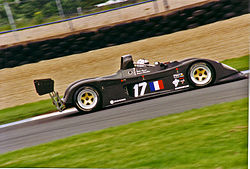Debora LMP296
 |
|||||
| Constructor | Debora | ||||
|---|---|---|---|---|---|
| Designer(s) |
Roger Rimmer (chassis) Didier Bonnet (body) |
||||
| Predecessor | Debora LMP295 | ||||
| Successor | Debora LMP200 | ||||
| Technical specifications | |||||
| Chassis | Aluminium honeycomb monocoque, with carbon fibre-reinforced cockpit | ||||
| Suspension (front) | KONI double-wishbone suspension | ||||
| Suspension (rear) | KONI double-wishbone suspension | ||||
| Engine |
Cosworth 1,994 cc (121.7 cu in) turbocharged I4 Alfa Romeo 3,000 cc (183.1 cu in) naturally-aspirated V6 BMW 3,000–3,200 cc (183.1–195.3 cu in) naturally-aspirated I6 Nissan 3,000 cc (183.1 cu in) naturally-aspirated V6 mid-engined |
||||
| Transmission | Hewland FGC 5-speed | ||||
| Weight | 650–700 kg (1,433.0–1,543.2 lb) | ||||
| Tyres | Michelin | ||||
| Competition history | |||||
| Notable entrants |
Didier Bonnet Racing P. R. Bruneau |
||||
| Debut | LMP296: 1996 24 Hours of Le Mans LMP297: 1997 International Sports Racing Series Donington 2000 SportsRacing World Cup Barcelona |
||||
|
|||||
| Teams' Championships | 1: (1998 ISRS, SR2 category) | ||||
The Debora LMP296 was a Le Mans Prototype, built by Debora Automobiles in 1996 for use in the 24 Hours of Le Mans. The car was originally entered with a 2-litre turbocharged Cosworth straight-four engine, but several other engines were used in the car's three-year career. Two cars are known to have been built. In conjunction with the LMP297, the car helped Waterair Sport to the International Sports Racing Series SR2 Team's Championship in 1998. The LMP296 was updated into the LMP299 for 2000.
The LMP296's chassis was developed by Roger Rimmer, whilst its bodywork was designed by Didier Bonnet. It featured an aluminium honeycomb monocoque chassis, and its open-top bodywork was made from carbon fibre. When it was initially built, it featured a Ford Escort RS Cosworth-derived 2-litre turbocharged straight-four engine, race-prepared by Fochesato, and capable of a claimed maximum output of 370 hp (276 kW; 375 PS) The engine's power was transmitted to the wheels via a 5-speed Hewland FGC transmission. The LMP296 used double-wishbone suspension developed by KONI, and its Michelin-shod 16" wheels were stopped by Alcon disc brakes, with 4-piston calipers. In 1998, various other engines were experimented with; a 3-litre Alfa Romeo V6 engine, 3- and 3.2-litre BMW straight-six engines, before the team finally settled on the 3-litre BMW unit after the 1998 24 Hours of Le Mans.
...
Wikipedia
